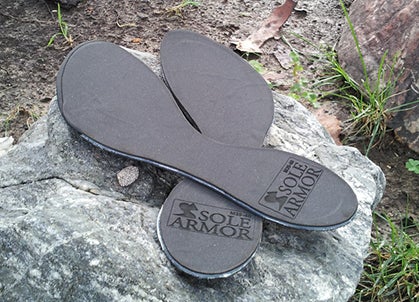New perk! Get after it with local recommendations just for you. Discover nearby events, routes out your door, and hidden gems when you sign up for the Local Running Drop.
After-market rock protection for your favorite minimalist shoes

What is Sole Armor?
Minimalist-shoe enthusiasts love wearing their footwear because it’s fast, nimble and reputed to encourage a lower-impact stride—but most would agree that running on rocks in minimal shoes, particularly for long distances, isn’t sustainable.
Sourced and manufactured in the USA, Sole Armor is a customizable rock plate designed to extend the life and tolerability of using Vibram Fivefingers (VFF) and other minimal footwear. It offers an extra layer of protection for running on rocky trails, hard-packed surfaces, ice and pavement—without compromising the “minimalist feel” of the shoes.
Sole Armor features a flexible plastic core that serves as the rock plate. Neoprene rubber on the bottom helps keep the insert in place, while softer foam on the top is designed to feel cozy against bare feet.
Comparison of Models
There are four models to choose from, all of which come in sizes with 2cm-length increments, and can easily be trimmed to fit your shoes:
- Vibram Style with Regular Protection ($17 – Designed for Fivefingers; 0.75mm extra rock protection in a stack height of 3mm)
- Vibram Style with Pro Protection ($19 – Designed for Fivefingers; 1.0mm extra rock protection in a stack height of 3.25mm)
- Regular Shoe Style with Regular Protection ($17 – Designed for minimalist shoes with single toebox; 0.75mm extra rock protection in a stack height of 3mm)
- Regular Shoe Style with Pro Protection ($19 – Designed for minimalist shoes with single toebox; 1.0mm extra rock protection in a stack height of 3.25mm)
A Wear Tester’s Impressions
I first tried the Vibram models, alternating them between my thinnest and oldest pairs of VFF—my KSOs—and a pair of more rugged VFF Treksports in which I’ve run races of up to 50 miles. The Sole Armor was easiest to fit into the KSOs, since my pair is older and stretchier than most. Be aware that your feet may get a little more cramped because the soles take up space—though this can also come in handy for shoes that run slightly big.
My primary runs were with the Pro Sole Armor on ice and hard-packed trails with small rocks. My feet felt solid and strong, and I hardly felt any impact from the ice or rocks. I was able to run faster and noticed my feet didn’t suffer the same bruising that they have during long runs in my VFF.
Sole Armor offers protection from the heel to the forefoot, but not the toes—so, when running on more technical terrain, sometimes my toes bore a little more brunt of impact without the additional protection.
With the Regular model designed for shoes with a single toebox, I tried them in both my well-worn New Balance MT110s and my Inov-8 BareGrip 200s. They offered quite the solid sole for my MT110s, which are toward the end of their life and have lost most of the durability of their built-in rock plates. There was a noticeable difference in thickness and even added warmth when running through snow. (On a sidenote, if you’ve run in wet conditions, it helps to remove the Sole Armor inserts post-run, to help everything dry out faster.)
I hadn’t worn my BareGrip shoes much recently, as they are a tad big and have left me feeling too many pointy rocks on technical trails. Sole Armor transformed them into solid, rugged trail shoes that I wanted to wear again. I was able to tackle some serious mud and rocks, and my feet were left happy, un-bruised and confident at each step.
Overall, I preferred the Pro model in all situations, because having the extra 0.25mm of protection felt both necessary and worth it.
(Want to learn more? Check out the Sole Armor website.)
Jonathan Loewus-Deitch has been hitting the trails in and around Washington, DC, since moving there four years ago from the Pacific Northwest. He run-commutes daily to his office by the White House, often taking the long way through the Rock Creek Park trails, and spends weekends outside the city running trails and ultras in the mountains.